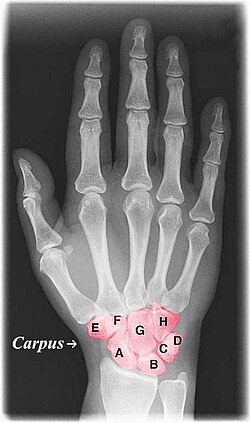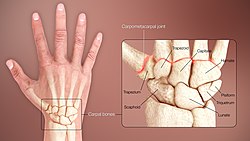Thecarpal bonesare the eight smallbonesthat make up thewrist(carpus) that connects thehandto theforearm.The terms "carpus" and "carpal" are derived from theLatincarpusand theGreekκαρπός(karpós), meaning "wrist". Inhuman anatomy,the main role of the carpal bones is toarticulatewith theradialandulnarheads to form a highly mobilecondyloid joint(i.e.wrist joint),[1]to provide attachments forthenarandhypothenarmuscles, and to form part of the rigidcarpal tunnelwhich allows themedian nerveandtendonsof theanterior forearm musclesto be transmitted to the hand andfingers.
| Carpal bones | |
|---|---|
 | |
 Labelled image showing the eight carpal bones. | |
| Details | |
| Identifiers | |
| Latin | os carpale pl. ossa carpi |
| MeSH | D002348 |
| TA98 | A02.4.08.001 |
| TA2 | 1249 |
| FMA | 23889 |
| Anatomical terms of bone | |
Intetrapods,thecarpusis the sole cluster of bones in the wrist between theradiusandulnaand themetacarpus.The bones of the carpus do not belong to individualfingers(or toes in quadrupeds), whereas those of the metacarpus do. The corresponding part of thefootis thetarsus.The carpal bones allow the wrist to move and rotate vertically.[1]
Structure
editBones
editThe eight carpal bones may be conceptually organized as either two transverse rows, or three longitudinal columns.
When considered as paired rows, each row forms an arch which is convex proximally and concave distally. On the palmar side, the carpus is concave and forms thecarpal tunnel,which is covered by theflexor retinaculum.[2]The proximal row comprises thescaphoid,lunate,triquetral,andpisiform boneswhich articulate with the surfaces of the radius and distal carpal row, and thus constantly adapts to these mobile surfaces. Within the proximal row, each carpal bone has slight independent mobility. For example, the scaphoid contributes to midcarpal stability by articulating distally with the trapezium and the trapezoid. In contrast, the distal row is more rigid as its transverse arch moves with themetacarpals.[3]
Biomechanicallyand clinically, the carpal bones are better conceptualized as three longitudinal columns:[4]
- Radial scaphoid column: scaphoid, trapezium, and trapezoid
- Lunate column: lunate and capitate
- Ulnar triquetral column: triquetrum and hamate
In this context the pisiform is regarded as asesamoid boneembedded in the tendon of theflexor carpi ulnaris.[4]The ulnar column leaves a gap between the ulna and the triquetrum, and therefore, only the radial or scaphoid and central or capitate columns articulate with the radius. The wrist is more stable in flexion than in extension more because of the strength of various capsules and ligaments than the interlocking parts of the skeleton.[3]
Almost all carpals (except the pisiform) have six surfaces. Of these thepalmaroranteriorand thedorsalorposterior surfacesare rough, for ligamentous attachment; the dorsal surfaces being the broader, except in the lunate.
Thesuperiororproximal,andinferiorordistal surfacesare articular, the superior generally convex, the inferior concave; themedialandlateral surfacesare also articular where they are in contact with contiguous bones, otherwise they are rough and tuberculated.
The structure in all is similar:cancelloustissue enclosed in a layer ofcompact bone.
Joints
edit| Name | Proximal/radial articulations |
Lateral/medial articulations |
Distal/metacarpal articulations |
|---|---|---|---|
| Proximal row | |||
| Scaphoid | radius | capitate, lunate | trapezium, trapezoid |
| Lunate | radius, articular disk | scaphoid, triquetral | capitate, hamate (sometimes) |
| Triquetrum | articular disk | lunate, pisiform | hamate |
| Pisiform | triquetral | ||
| Distal row | |||
| Trapezium | scaphoid | trapezoid | firstandsecond metacarpal |
| Trapezoid | scaphoid | trapezium, capitate | second metacarpal |
| Capitate | scaphoid, lunate | trapezoid, hamate | third,partly second andfourth metacarpal |
| Hamate | triquetral, lunate | capitate | fourth andfifth |
Accessory bones
editOccasionallyaccessory bonesare found in the carpus, but of more than 20 such described bones, only four (the central, styloid, secondary trapezoid, and secondary pisiform bones) are considered to be proven accessory bones. Sometimes the scaphoid, triquetrum, and pisiform bones are divided into two. [2]
Development
edit| Bone | Average | Variation[6] | Variation[7] |
|---|---|---|---|
| Capitate | 2.5 months | 1–6 months | 1–5 months |
| Hamate | 4–5.5 months | 1–7 months | 1–12 months |
| Triquetrum | 2 years | 5 months to 3 years | 9 months to 4 years and 2 months |
| Lunate | 5 years | 2–5.5 years | 18 months to 4 years and 3 months |
| Trapezium | 6 years | 4–8 years | |
| Trapezoid | 6 years | 4–8 years | |
| Scaphoid | 6 years | 4–7 years | |
| Pisiform | 12 years | 8–12 years |
The carpal bones areossified endochondrally(from within the cartilage) and the ossific centers appear only after birth. [5] The formation of these centers roughly follows a chronological spiral pattern starting in the capitate and hamate during the first year of life. The ulnar bones are then ossified before the radial bones, while the sesamoid pisiform arises in the tendon of theflexor carpi ulnarisafter more than ten years. [6]The commencement of ossification for each bone occurs over period like other bones. This is useful in forensic age estimation.[7]
Function
editLigaments
editThere are four groups of ligaments in the region of the wrist:[8]
- The ligaments of thewristproper which unite theulnaandradiuswith the carpus: theulnarandradial collateral ligaments;thepalmaranddorsal radiocarpal ligaments;and thepalmar ulnocarpal ligament.(Shown in blue in the figure.)
- The ligaments of theintercarpal articulationswhich unite the carpal bones with one another: theradiate carpal ligament;thedorsal,palmar,andinterosseous intercarpal ligaments;and thepisohamate ligament.(Shown in red in the figure.)
- The ligaments of thecarpometacarpal articulationswhich unite the carpal bones with the metacarpal bones: thepisometacarpal ligamentand thepalmaranddorsal carpometacarpal ligaments.(Shown in green in the figure.)
- The ligaments of theintermetacarpal articulationswhich unite the metacarpal bones: the dorsal, interosseous, and palmar metacarpal ligaments. (Shown in yellow in the figure.)
Movements
editThe hand is said to be instraight positionwhen the third finger runs over the capitate bone and is in a straight line with the forearm. This should not be confused with themidpositionof the hand which corresponds to an ulnar deviation of 12 degrees. From the straight position two pairs of movements of the hand are possible:abduction(movement towards the radius, so called radial deviation or abduction) of 15 degrees andadduction(movement towards the ulna, so called ulnar deviation or adduction) of 40 degrees when the arm is in strictsupinationand slightly greater in strictpronation. [9] Flexion(tilting towards the palm, so called palmar flexion) andextension(tilting towards the back of the hand, so called dorsiflexion) is possible with a total range of 170 degrees. [10]
Radial abduction/ulnar adduction
editRight:Radial abduction
Right:Palmar flexion
Duringradial abductionthe scaphoid is tilted towards the palmar side which allows the trapezium and trapezoid to approach the radius. Because the trapezoid is rigidly attached to the second metacarpal bone to which also the flexor carpi radialis and extensor carpi radialis are attached, radial abduction effectively pulls this combined structure towards the radius. During radial abduction the pisiform traverses the greatest path of all carpal bones. [9] Radial abduction is produced by (in order of importance)extensor carpi radialis longus,abductor pollicis longus,extensor pollicis longus,flexor carpi radialis,andflexor pollicis longus. [11]
Ulnar adductioncauses a tilting or dorsal shifting of the proximal row of carpal bones.[9] It is produced byextensor carpi ulnaris,flexor carpi ulnaris,extensor digitorum,andextensor digiti minimi.[11]
Both radial abduction and ulnar adduction occurs around a dorsopalmar axis running through the head of the capitate bone. [9]
Palmar flexion/dorsiflexion
editDuringpalmar flexionthe proximal carpal bones are displaced towards thedorsalside and towards thepalmarside duringdorsiflexion.While flexion and extension consist of movements around a pair of transverse axes — passing through the lunate bone for the proximal row and through the capitate bone for the distal row — palmar flexion occurs mainly in theradiocarpal jointand dorsiflexion in themidcarpal joint. [10]
Dorsiflexion is produced by (in order of importance)extensor digitorum,extensor carpi radialis longus,extensor carpi radialis brevis,extensor indicis,extensor pollicis longus,andextensor digiti minimi.Palmar flexion is produced by (in order of importance)flexor digitorum superficialis,flexor digitorum profundus,flexor carpi ulnaris,flexor pollicis longus,flexor carpi radialis,andabductor pollicis longus. [11]
Combined movements
editCombined with movements in both the elbow and shoulder joints,intermediateorcombined movementsin the wrist approximate those of aball-and-socket jointwith some necessary restrictions, such as maximum palmar flexion blocking abduction.[10]
Accessory movements
editAnteroposteriorgliding movements between adjacent carpal bones or along the midcarpal joint can be achieved by stabilizing individual bones while moving another (i.e. gripping the bone between the thumb and index finger). [12]
Other animals
editThe structure of the carpus varies widely between different groups oftetrapods,even among those that retain the full set of five digits. In primitive fossilamphibians,such asEryops,the carpus consists of three rows of bones; a proximal row of three carpals, a second row of four bones, and a distal row of five bones. The proximal carpals are referred to as theradiale,intermedium,andulnare,after their proximal articulations, and arehomologouswith the scaphoid, lunate, and triquetral bones respectively. The remaining bones are simply numbered, as the first to fourthcentralia(singular:centrale), and the first to fifthdistal carpals.Primitively, each of the distal bones appears to have articulated with a single metacarpal.
However, the vast majority of latervertebrates,including modernamphibians,have undergone varying degrees of loss and fusion of these primitive bones, resulting in a smaller number of carpals. Almost allmammalsandreptiles,for example, have lost the fifth distal carpal, and have only a single centrale - and even this is missing in humans. The pisiform bone is somewhat unusual, in that it first appears in primitive reptiles, and is never found in amphibians.
Because many tetrapods have fewer than five digits on the forelimb, even greater degrees of fusion are common, and a huge array of different possible combinations are found. The wing of a modernbird,for example, has only two remaining carpals; the radiale (the scaphoid of mammals) and a bone formed from the fusion of four of the distal carpals.[13]
The carpus and tarsus are both described as podial elements or (clusters of) podial bones.[14]
In somemacropods,the scaphoid and lunar bones are fused into the scapholunar bone.[15]
Incrustaceans,"carpus" is the scientific term for the claws or "pincers" present on some legs. (SeeDecapod anatomy)
Etymology
editThe Latin word "carpus" is derived from Greekκαρπὁςmeaning "wrist". The root "carp-" translates to "pluck",an action performed by the wrist.[16]
See also
editNotes
edit- ^abKingston 2000, pp 126-127
- ^abPlatzer 2004, p 124
- ^abSchmidt-Lanz 2003, p 29
- ^abThieme Atlas of Anatomy2006, p 224
- ^abPlatzer 2004, p 126
- ^abcSchmidt, Hans-Martin; Lanz, Ulrich (2003).Surgical Anatomy of the Hand.Thieme. p. 7.ISBN1-58890-007-X.
- ^abcBalachandran, Ajay; Kartha, Moumitha; Krishna, Anooj; Thomas, Jerry; K, Prathilash; TN, Prem; GK, Libu; B, Krishnan; John, Liza (2014)."A Study of Ossification of Capitate, Hamate, Triquetral & Lunate in Forensic Age Estimation".Indian Journal of Forensic Medicine & Toxicology.8(2): 218–224.doi:10.5958/0973-9130.2014.00720.8.ISSN0973-9130.Archivedfrom the original on 25 January 2020.Retrieved18 August2014.
- ^Platzer 2004, p 130
- ^abcdPlatzer 2004, p 132
- ^abcPlatzer 2004, p 134
- ^abcPlatzer 2004, p 172
- ^Palastanga 2006, p 184
- ^Romer, Alfred Sherwood; Parsons, Thomas S. (1977).The Vertebrate Body.Philadelphia, PA: Holt-Saunders International. pp. 200–202.ISBN0-03-910284-X.
- ^Galateanu, Gabriela; Hildebrandt, Thomas B.; Maillot, Alexis; Etienne, Pascal; Potier, Romain; Mulot, Baptiste; Saragusty, Joseph; Hermes, Robert (2013-07-09)."One Small Step for Rhinos, One Giant Leap for Wildlife Management- Imaging Diagnosis of Bone Pathology in Distal Limb".PLOS ONE.8(7): e68493.Bibcode:2013PLoSO...868493G.doi:10.1371/journal.pone.0068493.ISSN1932-6203.PMC3706412.PMID23874643.
- ^Swamp Wallaby (Wallabia bicolor) carpalsArchived2007-09-30 at theWayback Machine
- ^Diab 1999, p 48
References
edit- Diab, Mohammad (1999).Lexicon of Orthopaedic Etymology.Taylor & Francis.ISBN90-5702-597-3.
- Kingston, Bernard (2000).Understanding joints: a practical guide to their structure and function.Nelson Thornes.ISBN0-7487-5399-0.
- Palastanga, Nigel; Field, Derek; Soames, Roger (2006).Anatomy and human movement: structure and function.Elsevier Health Sciences.ISBN0-7506-8814-9.
- Platzer, Werner (2004).Color Atlas of Human Anatomy, Vol. 1: Locomotor System(5th ed.).Thieme.ISBN3-13-533305-1.
- Schmidt, Hans-Martin; Lanz, Ulrich (2003).Surgical anatomy of the hand.Thieme.ISBN1-58890-007-X.
- Thieme Atlas of Anatomy: General Anatomy and Musculoskeletal System.Thieme. 2006.ISBN1-58890-419-9.
External links
edit- Anatomy photo:08:os-0101at the SUNY Downstate Medical Center— "Palm of the Hand:Carpal bones"
- Hand kinesiology at the University of Kansas Medical Center